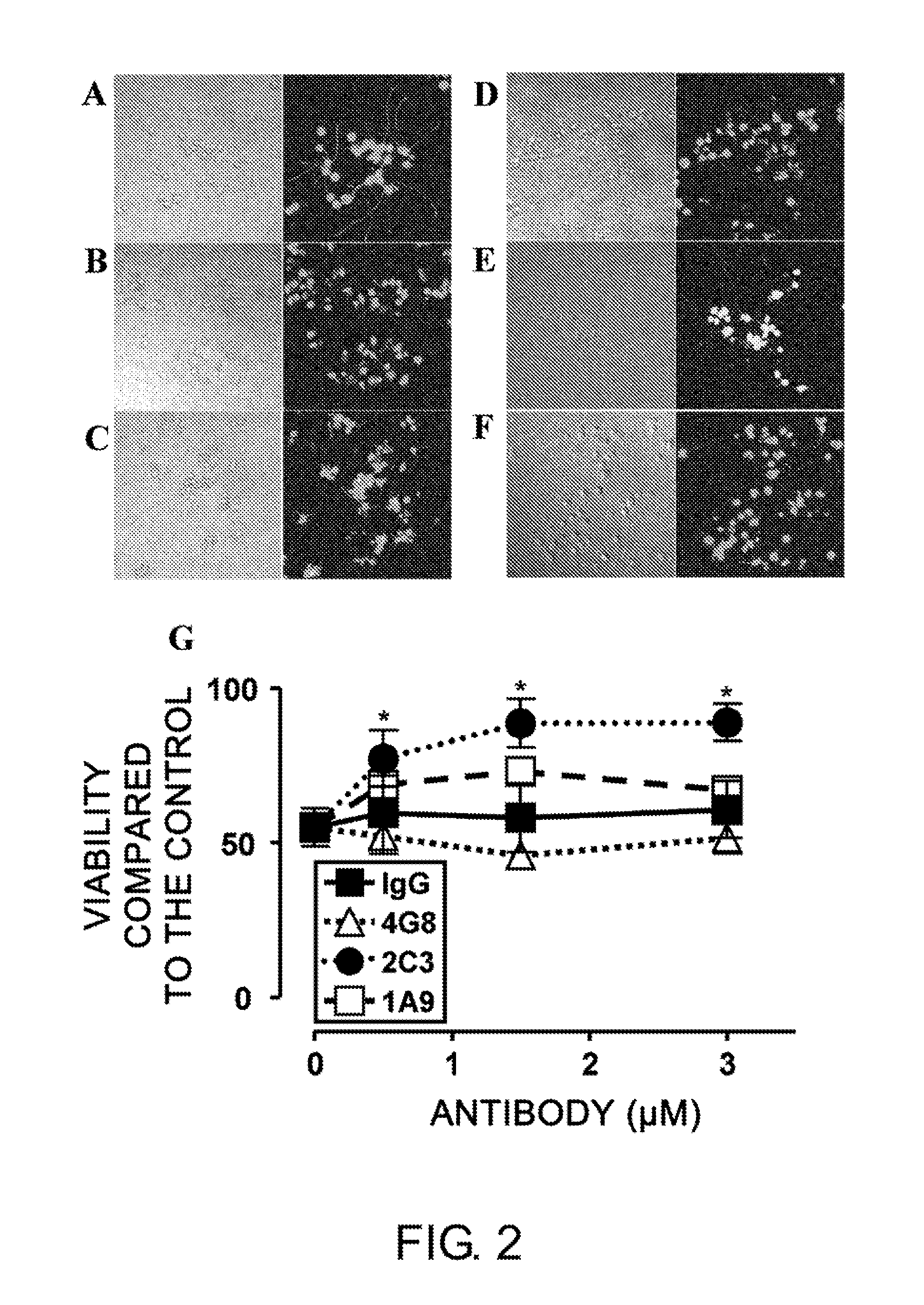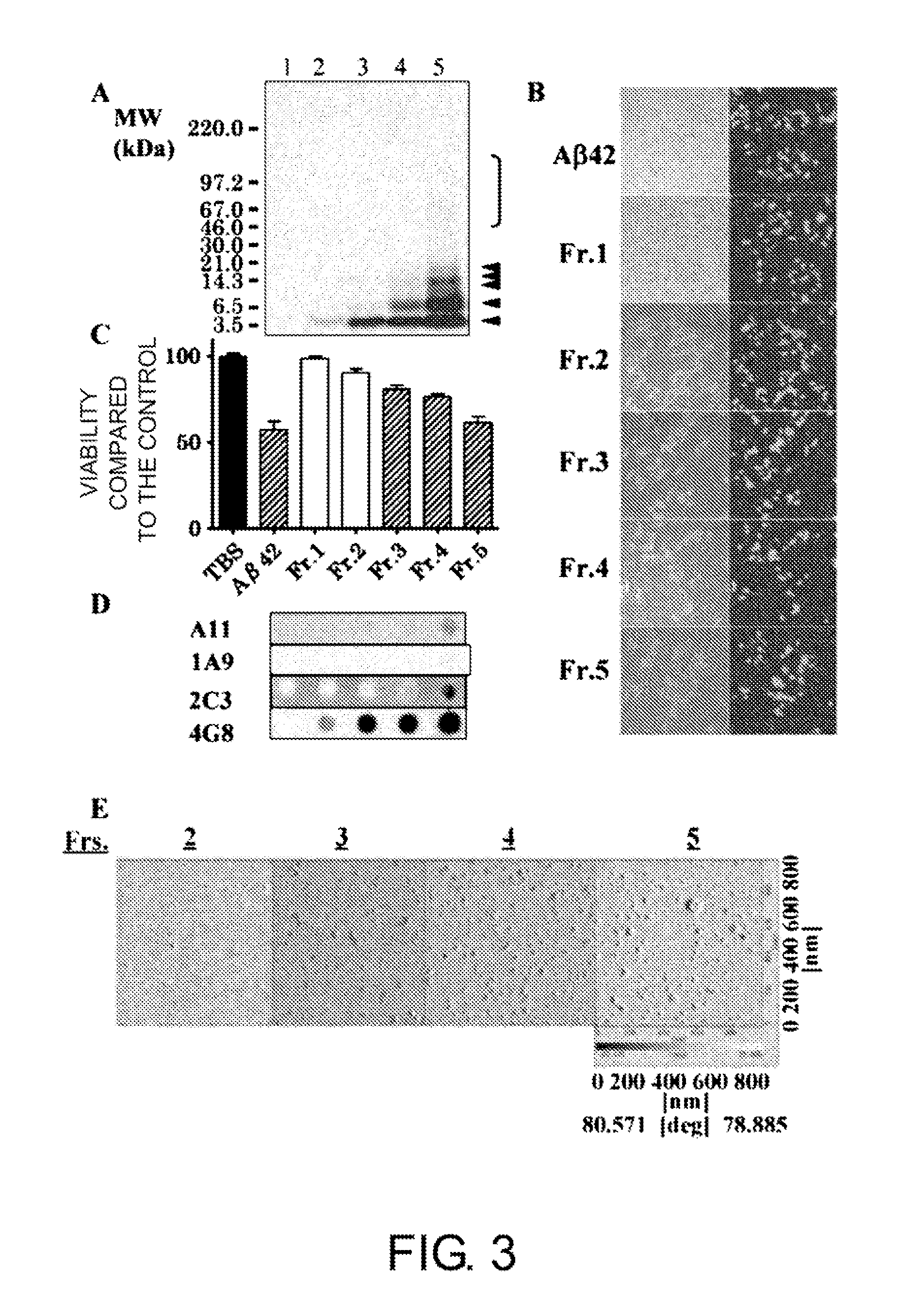Antibodies that specifically bind to Aβ oligomers and uses thereof
a technology of a oligomers and antibodies, applied in the field of antibodies that specifically bind to a oligomers, can solve the problems of inability to demonstrate synaptic toxicity of endogenous a oligomers, no technique capable of proving toxicity within the human brain, and difficult demonstration, so as to suppress a amyloid fibril formation and prevent the development. , the effect of preventing the formation of a amyloid fibrils
- Summary
- Abstract
- Description
- Claims
- Application Information
AI Technical Summary
Benefits of technology
Problems solved by technology
Method used
Image
Examples
example 1
Preparation of Aβ Oligomer-Specific Monoclonal Antibodies (1A9 and 2C3)
[0325]Aβ oligomers and monomers co-exist in a solution. Thus, it is essential to remove Aβ monomers for preparation of antigens to produce Aβ oligomer-specific antibodies. As shown in FIG. 1A, the present inventors succeeded in isolating SDS-stable Aβ tetramers without contamination of Aβ monomers by SDS-PAGE. After in vivo immunization with the isolated Aβ tetramers, positive hybridoma clones were selected by two-step screening using dot blot analysis followed by immunoprecipitation. Among 400 clones subjected to dot blot analysis, 16 clones were determined to be positive (positivity rate=4%). To assess the specificity of the isolated positive clones to the oligomers, a phosphate buffer-insoluble and formic acid (FA)-soluble amyloid fraction derived from AD brain (Matsubara E et al., Neurobiol Aging, 25: 833-841, 2004) was analyzed by immunoprecipitation using the cell culture supernatants of the positive hybrid...
example 2
The Anti-Neurotoxic Activity of Monoclonal 1A9 and 2C3
[0326]To assess whether monoclonal 1A9 and 2C3 can prevent Aβ-induced neurotoxicity, NGF-differentiated PC12 cells (PC12N) were incubated with 25 μM seed-free Aβ 1-42 (ThT-negative 540,000×g supernatant) in the presence or absence of the monoclonal antibodies (mAbs) at 37° C. for 48 hours. The viability of nerve cells was determined by LIVE / DEAD assay (FIG. 2). Nerve cell death was detected at a significantly high level (50%) in the presence of Aβ 1-42 (FIGS. 2B and 2G), as compared to the control assay (FIG. 2A). Non-specific IgG2b (FIGS. 2C and 2G) could not inhibit the Aβ 1-42-induced neurotoxicity under the same conditions. The commercially available Aβ-specific monoclonal antibody 4G8 (IgG2b isotype; FIGS. 2D and 2G) had a tendency to enhance the toxicity. Monoclonal 2C3 (IgG2b isotype; FIGS. 2F and 2G) neutralized the neurotoxicity of Aβ 1-42 almost completely in a concentration-dependent manner. Thus, the de novo-formed ne...
example 3
[0327]Currently, the determination of the precise size and conformation of neurotoxic Aβ 1-42 oligomers is one of the most urgent issues and which is subjected to intense competition. The present inventors succeeded in isolating soluble neurotoxic Aβ 1-42 molecular species and fractionating the species into the following five fractions by ultrafiltration and molecular sieving (UC / MS) (FIG. 3A):[0328]fraction 1, filtrate of [0329]fraction 2, filtrate of 3 to 10 kDa (lane 2);[0330]fraction 3, filtrate of 10 to 30 kDa (lane 3);[0331]fraction 4, filtrate of 30 to 100 kDa (lane 4); and[0332]fraction 5, retention solution of >100 kDa (lane 5).
[0333]The immunoblot analysis using monoclonal 4G8 (FIG. 3A) revealed that:[0334]fraction 1 does not contain Aβ (lane 1);[0335]fraction 2 contains Aβ monomers (lane 2);[0336]fraction 3 contains Aβ monomers and a small amount of Aβ dimers (lane 3);[0337]fraction 4 contains Aβ monomers to pentamers (lane 4); and[0338]fraction 5 contains Aβ monomers to ...
PUM
 Login to View More
Login to View More Abstract
Description
Claims
Application Information
 Login to View More
Login to View More - R&D
- Intellectual Property
- Life Sciences
- Materials
- Tech Scout
- Unparalleled Data Quality
- Higher Quality Content
- 60% Fewer Hallucinations
Browse by: Latest US Patents, China's latest patents, Technical Efficacy Thesaurus, Application Domain, Technology Topic, Popular Technical Reports.
© 2025 PatSnap. All rights reserved.Legal|Privacy policy|Modern Slavery Act Transparency Statement|Sitemap|About US| Contact US: help@patsnap.com



